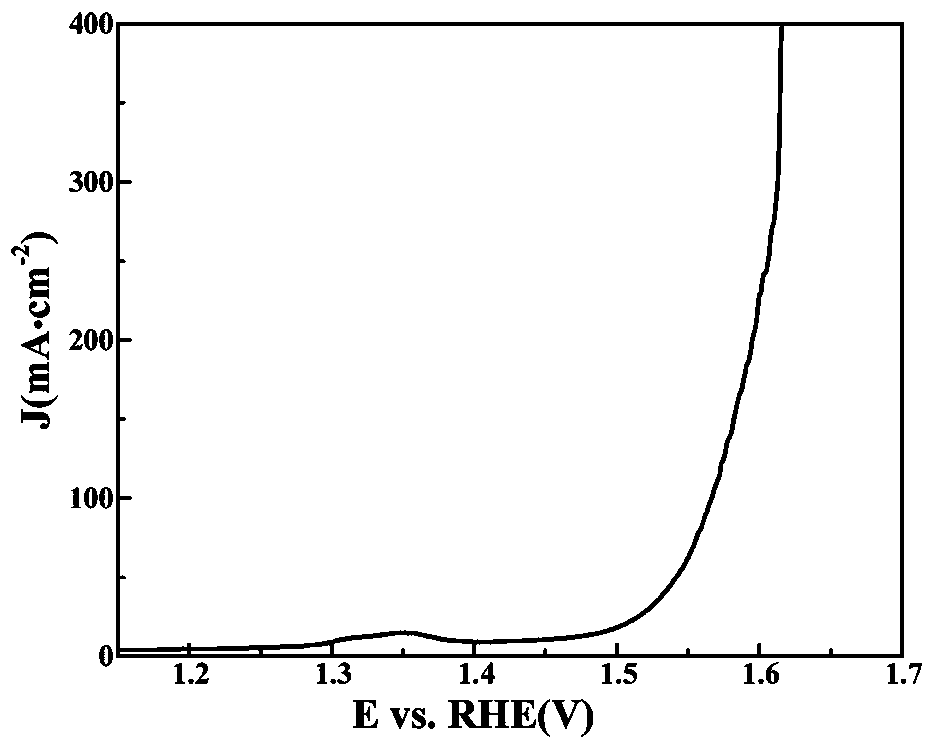Method for preparing multifunctional nickel-doped molybdenum disulfide in situ electrode by CVD (Chemical Vapor Deposition) method
A technology of molybdenum disulfide and in-situ electrodes, applied in electrodes, electrolytic processes, electrolytic components, etc., can solve the problems of increasing process complexity and cost
- Summary
- Abstract
- Description
- Claims
- Application Information
AI Technical Summary
Problems solved by technology
Method used
Image
Examples
Embodiment 1
[0027] At room temperature, dissolve nickel chloride and molybdenum chloride in ethanol solution, the concentration of nickel chloride is 40mM, the concentration of molybdenum chloride is 360mM, and the ratio of nickel atoms to the sum of the number of nickel atoms plus molybdenum atoms is 10%. Soak the carbon paper in the precursor solution, take it out, and dry it on a hot table at 80 °C for 10 min. Place the coated substrate in a tube furnace with N 2 Air vacuuming repeated three times to discharge the residual air in the tube furnace, and then pass N 2 Gas, the flow rate is 2SCCM, 1g of sulfur powder is placed on the upper part of the tube furnace, as the temperature in the tube furnace rises, the sulfur powder evaporates to form sulfur vapor, in N 2 React in +S atmosphere at 550°C for 3 hours, take it out after natural cooling. figure 1 (a) HER, (b) OER, (c) ORR linear voltammetry (LSV) diagrams of the Ni-doped molybdenum disulfide in-situ electrode prepared in Example ...
Embodiment 2
[0029] Dissolve nickel chloride and molybdenum chloride in ethanol solution at room temperature, wherein the concentration of molybdenum chloride is 360mM, and the ratio of nickel atoms to the sum of the number of nickel atoms plus molybdenum atoms is 10%. Soak the carbon paper in the precursor solution, take it out, and dry it on a hot table at 80 °C for 10 min. Put the coated substrate into the tube furnace, ventilate Ar gas to vacuumize repeatedly three times to discharge the residual air in the tube furnace, then vent Ar gas, the flow rate is 2SCCM, 1g of sulfur powder is placed on the upper part of the tube furnace, along with When the temperature in the tube furnace rises, the sulfur powder evaporates to form sulfur vapor, react in Ar+S atmosphere at 800°C for 45min, and take it out after natural cooling. figure 2 OER linear voltammetry (LSV) diagram of the Ni-doped molybdenum disulfide in-situ electrode prepared in Example 2. As can be seen from the figure, the electr...
Embodiment 3
[0031] Dissolve nickel chloride and molybdenum chloride in ethanol solution at room temperature, wherein the concentration of molybdenum chloride is 360mM, and the ratio of nickel atoms to the sum of the number of nickel atoms plus molybdenum atoms is 10%. Soak the carbon paper in the precursor solution, take it out, and dry it on a hot table at 80 °C for 10 min. Put the coated substrate into the tube furnace, and repeatedly discharge the residual air in the tube furnace with Ar gas and vacuumize it three times, and then pass Ar gas at a flow rate of 1 SCCM. As the temperature in the tube furnace rises, the sulfur powder evaporates to form sulfur vapor, react at 800°C for 45 minutes in an Ar+S atmosphere, and take it out after natural cooling. image 3 The OER linear voltammetry (LSV) diagram of the Ni-doped molybdenum disulfide in-situ electrode prepared in Example 3. It can be seen from the figure that the electrode prepared in this embodiment has good oxygen evolution perf...
PUM
 Login to View More
Login to View More Abstract
Description
Claims
Application Information
 Login to View More
Login to View More - R&D
- Intellectual Property
- Life Sciences
- Materials
- Tech Scout
- Unparalleled Data Quality
- Higher Quality Content
- 60% Fewer Hallucinations
Browse by: Latest US Patents, China's latest patents, Technical Efficacy Thesaurus, Application Domain, Technology Topic, Popular Technical Reports.
© 2025 PatSnap. All rights reserved.Legal|Privacy policy|Modern Slavery Act Transparency Statement|Sitemap|About US| Contact US: help@patsnap.com



